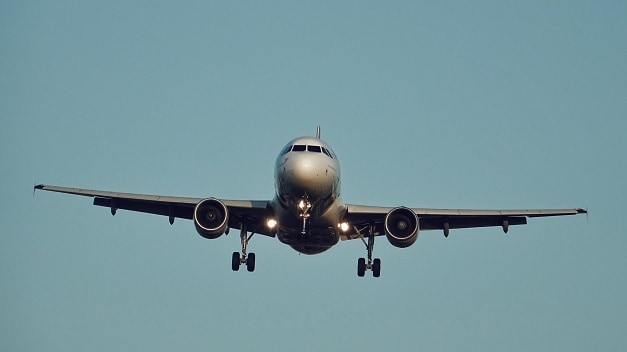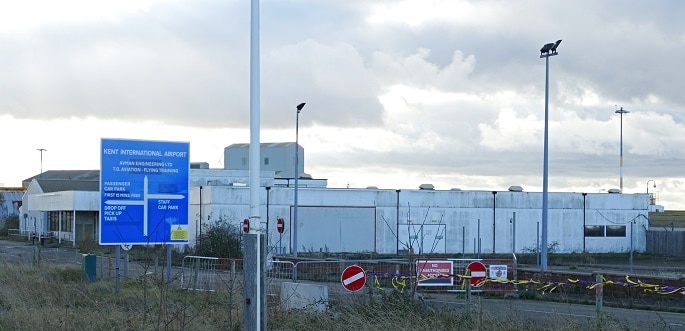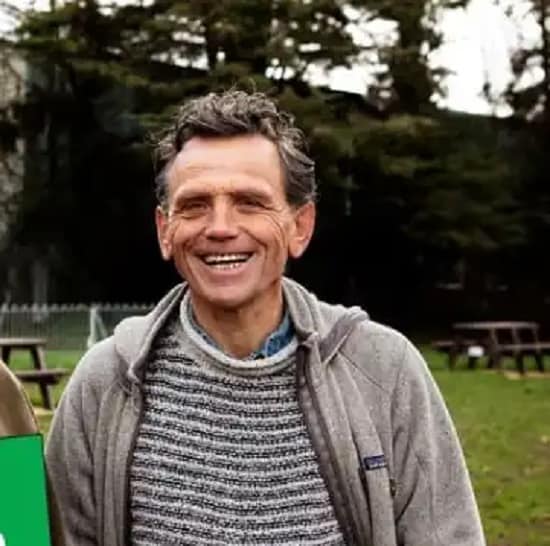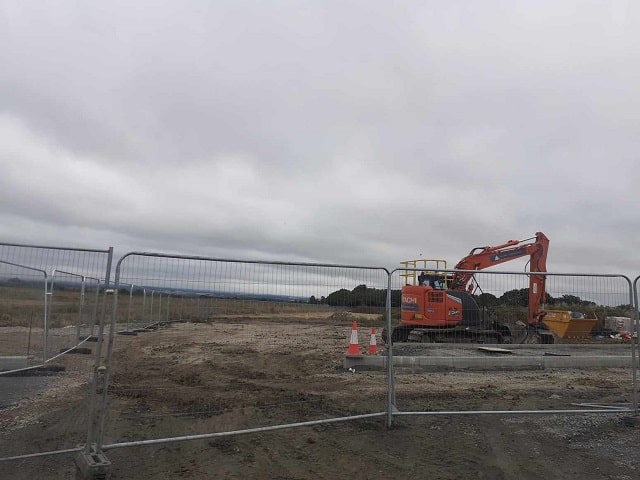
Thanet council’s climate change officer has presented a report to councillors examining predicted carbon emissions from Manston airport and says a woodland area equivalent to twice the size of Thanet would need to be planted to offset the new aircraft emissions by year 18 of operation.
Dr Hannah Scott says calculations are based on a response issued by airport owners RiverOak Strategic Partners in October 2022 to questions raised by Thanet Green Party. The response includes data from an Environmental Statement submitted as part of the airport Development Consent Order process.
RSP says the council report contains “several errors in overestimating the airport’s carbon emissions.”

The report to councillors says embodied carbon is the CO2 emissions released when creating materials and relevant structures needed in a project such as new concrete or metal used in parking facilities or a new hangar at the airport. Embodied emissions for the airport are estimated to be 636,000 tonnes of CO2.
It adds: “A majority of the construction work on the airport infrastructure is complete by Year 2 in time for opening”
The emissions released from the day to day running of the airport on the ground are estimated at a total 9,000 tonnes of CO2e per year. This is calculated from the buildings that will be in operation at the airport. Ground support equipment will release 400 tonnes of CO2e in year 2 and 1,800 tonnes of CO2e in year 20.
The report adds: “RSP has committed to become net zero in their on the ground operations within 5 years of opening (by 2030), which will address these operational emissions.”
Emission estimates from extra car and bus journeys and from the lorries delivering and collecting freight from the airport totals 13,900 tonnes per year. These could possibly increase to 36,000 tonnes of CO2 in year 20 due to increased business.
The report says: “The overwhelming majority of airport greenhouse gas (GHG) emissions arise from the combustion of fuel in the cruise and landing and take-off cycle of aircraft.”

These emissions are estimated in the report at 221,800 tonnes of CO2 per year from year 2 possibly rising to 730,000 tonnes of CO2 per year in the 20th year of operation – the report notes that figure is without the use of sustainable aviation fuel.
TDC’s climate advisory group was told: “According to the RSP report, in year 20 of operations, due to the predicted increase in flights, the aircraft will create significantly more emissions than the whole of Thanet from all sectors put together (730,100 tonnes of CO2 from the aircraft compared to 499,100 tonnes of CO2 from the whole of Thanet).
“Simply as an illustration of the volume of emissions created, the report set out an analysis of offsetting the aircraft emissions. It was noted that to offset new emissions from the aircraft in the second year, 1,109 hectares of woodland needed to be planted that year and every year after. This is the equivalent of 1,478 football pitches each year.
“19,962 hectares of woodland would need to be planted to fully offset emissions (1,109 hectares x 18 years). Thanet is 10,000 hectares in size, so a woodland area equivalent to twice the size of Thanet would be needed to offset these new aircraft emissions.”
Aviation offsetting would not be the responsibility of Thanet council as UK Government is responsible for the reduction of emissions from airports, ports and military transport
RSP says it will develop a Carbon Minimisation Action Plan to reduce greenhouse gas emissions associated with the airport.
TDC has resolved to keep a watching brief on the adherence to the low emission plan at Manston airport.
Members of the committee agreed to invite RSP to a future council meeting, pending correct procedural rules being followed.

Tony Freudmann, from RSP, says the report to Thanet council contained “several errors.”
He said: “The report makes several errors in overestimating the airport’s carbon emissions and then assesses how to offset emissions most of which do not even apply.
“For example, the report acknowledges the commitment RSP has made that Manston ground operations will be net zero within five years of opening on page three, but then ignores that in calculating offsets on page six.
“Equally, the report acknowledges that aircraft emissions do not count towards Thanet’s carbon footprint on pages two and five, but then goes on to assess them as if they did in the following sections.
“On this basis, it is hard to see how its findings can offer any useful contribution to discussions.”
The RSP response to Thanet Green Party says: “As part of RSP’s Redetermination Submission as requested by the Secretary of State for the Manston Airport DCO, RSP reiterated the commitment made during the examination to be a net zero airport within five years of opening (by 2030).
“As a new airport, unburdened by old infrastructure and ground support equipment, Manston Airport is uniquely positioned to deliver a net zero carbon operation.
“The Jet Zero Strategy, published in July 2022, requires all airport operations in England to be zero emission by 2040, with the scope and implementation route to be defined following further consultation.”
Mitigation proposals submitted by RSP as part of the DCO process include:
- A strict routeing agreement for incoming and outgoing HGVs, avoiding, where possible, peak traffic flow hours in order to reduce congestion and queuing.
- Planning of aircraft arrival and departure scheduling to avoid, where possible, over-long idling, taxiing and hold times.
- Airfield layout design to minimise times taxiing and holding.
- Use of Fixed Electrical Ground Power (FEGP) to minimise engine/Auxiliary Power Unit (APU) use.
- Bans on older, dirtier aircraft
- Operation of a Ground Support Equipment fleet which will be fully electric (zero emission) by Year 20.
- Design of Jet-A1 fuel tanks to minimise release of vapour to ambient air

Thanet Green Party councillor Kevin Pressland says tree planting is not the best solution for carbon offsetting, which he branded as “greenwash.”
Instead, he says the use of hemp blocks in new build developments should be considered.
He said: “If sadly the judicial review supports the Manston Airport proposed development it is clear some other way of absorbing that atmospheric carbon has to be immediately enacted.
“As Greens we would propose a percentage of Hemp Blocks into all the new builds underway/proposed in Thanet and beyond.
“These hemp blocks sequester atmospheric carbon into the building and would also support an important break crop in a farmer’s rotation, this would also help to sequester more carbon into the soil by building soil fertility and vitality.

“We would urge the government to support such initiatives. This will likely not address the full co2 emissions the airport would produce, so while carbon offsetting rules do not allow for funding methods that would long term reduce carbon emissions like renewable energy in the form of solar panels and air source heat pumps on all new builds, as Greens we would encourage the government to enable RSP to fund these on all new builds of houses and commercial enterprises in Thanet and beyond.
“Once these systems work they will reduce carbon emissions and reduce the fossil fuel requirement that most houses are still reliant on. We would also urge eco insulation on all new builds and the reduced emissions achieved factored in as a form of carbon sequestration.
“Just to be very clear the Greens have always opposed this proposed airport, but will be pragmatic if it becomes a reality.
“Whilst I cannot speak for the Labour party I hope they are in agreement with our thinking on this matter.”
UK climate targets
Internationally, the UK has committed to climate targets under the Paris Agreement. The Paris Agreement provides for the international community to keep the increase in global average temperature to below 2°C above pre-industrial levels, and to pursue efforts to limit the temperature increase to 1.5°C.
Domestically, the UK government has legal targets committed to reaching net zero emissions by 2050, along with a series of interim carbon budgets (each covering a 5-year period) paving the trajectory towards the net zero target.
Recently, the UK announced the Sixth Carbon Budget level (2033-37) , equivalent to reducing emissions by around 78% by 2035 compared with 1990 levels.
In 2022, emissions from international aviation fuel use from UK bunkers were estimated to be 26.0 MtCO2e. This was nearly double the 2021 figure, when it was 13.3 MtCO2e, but was still 29.3% lower than in 2019, when it was 36.7 MtCO2e, which was the highest annual figure since these estimates begin in 1990.
In 2019, domestic and international aviation accounted for around 8% of UK CO2 equivalent emissions. Globally aviation’s CO2 accounted for 2.4% of emissions.
Carbon dioxide (CO2) emissions in the UK are provisionally estimated to have decreased by 2.4% in 2022 from 2021, to 331.5 million tonnes (Mt), and total greenhouse gas emissions by 2.2% to 417.1 million tonnes carbon dioxide equivalent (MtCO2e).
Cars, buses, trains, trucks, ships and planes, (unless electric and charged with renewable energy), all produce emissions by burning fossil fuels. In the UK, transport is the biggest contributor to climate change, responsible for 27% of emissions in 2019, mostly from cars.
Net Zero strategy
The briefing followed an update on Thanet council’s Net Zero strategy.
Thanet District Council pledged to make the council net zero by 2030 in the core carbon footprint. This included emissions the council has direct control over, for example the estates and activities.
A net zero directors groups had been set up specifically to address the core emissions, and to aim to achieve net zero by 2030.
The greatest emissions from Thanet as a whole stood with transport and emissions from homes.
A decision from the Royal Courts of Justice over whether correct process was followed in issuing a development consent order for Manston airport is awaited following a hearing which took place at the High Court on July 4-5.

